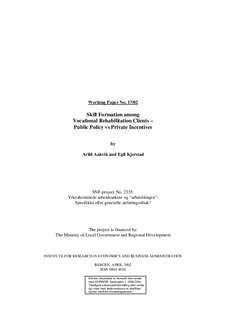| dc.description.abstract | In this paper we analyse individual vocational rehabilitation clients’ decisions to enter active training or not. Although the Government pays the direct costs of training, the composition of the total costs of training may be decisive for individual choices. Based on labour market theory, we relate background characteristics of the clients to monetary opportunity costs and non-monetary costs of training, arguing that training choices are a consequence of differences in costs of training. We use a ten percent sample of participants in educational programs, work related training and non-participants who entered the Norwegian vocational rehabilitation sector in the period from 1989 to 1993, a total of 6653 persons. We find that the background characteristics of persons investing in educational training differ along several dimensions compared both to persons attending work related training and to clients not participating in training at all. Keywords: public policy, private incentives, costs of training, educational training, work related training, vocational rehabilitation. | en |
